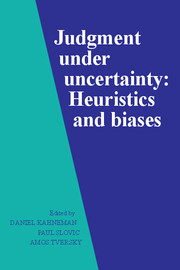Book contents
- Frontmatter
- Contents
- List of contributors
- Preface
- Part I Introduction
- Part II Representativeness
- Part III Causality and attribution
- Part IV Availability
- Part V Covariation and control
- Part VI Overconfidence
- Part VII Multistage evaluation
- Part VIII Corrective procedures
- Part IX Risk perception
- 33 Facts versus fears: Understanding perceived risk
- Part X Postscript
- References
- Index
33 - Facts versus fears: Understanding perceived risk
Published online by Cambridge University Press: 05 May 2013
- Frontmatter
- Contents
- List of contributors
- Preface
- Part I Introduction
- Part II Representativeness
- Part III Causality and attribution
- Part IV Availability
- Part V Covariation and control
- Part VI Overconfidence
- Part VII Multistage evaluation
- Part VIII Corrective procedures
- Part IX Risk perception
- 33 Facts versus fears: Understanding perceived risk
- Part X Postscript
- References
- Index
Summary
People respond to the hazards they perceive. If their perceptions are faulty, efforts at personal, public, and environmental protection are likely to be misdirected. For some hazards, such as motor vehicle accidents, extensive statistical data are readily available. For other familiar activities, such as the consumption of alcohol and tobacco, assessment of risk requires complex epidemiological and experimental studies. However, even when statistical data are plentiful, the “hard” facts can only go so far toward developing policy. At some point, human judgment is needed to interpret the findings and determine their relevance.
Still other hazards, such as those associated with recombinant DNA research or nuclear power, are so new that risk assessment must be based on complex theoretical analyses such as fault trees (see Figure 1), rather than on direct experience. Despite an appearance of objectivity, these analyses, too, include a large component of judgment. Someone, relying on educated intuition, must determine the structure of the problem, the consequences to be considered, and the importance of the various branches of the fault tree. Once the analyses have been performed, they must be communicated to those who actually manage hazards, including industrialists, environmentalists, regulators, legislators, and voters. If these people do not understand or believe the data they are shown, then distrust, conflict, and ineffective hazard management are likely.
- Type
- Chapter
- Information
- Judgment under UncertaintyHeuristics and Biases, pp. 463 - 490Publisher: Cambridge University PressPrint publication year: 1982
- 264
- Cited by



